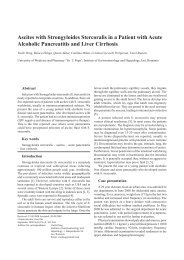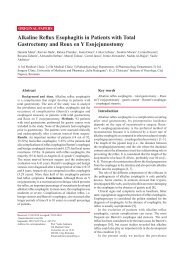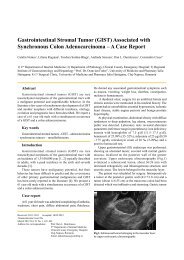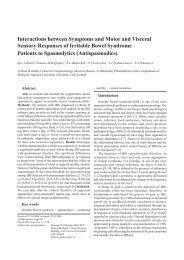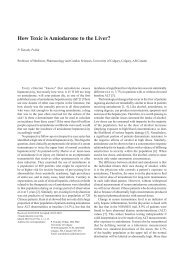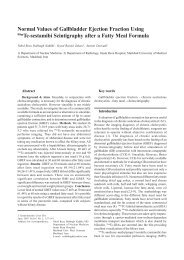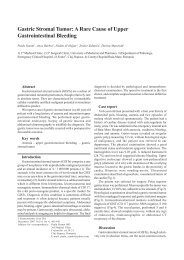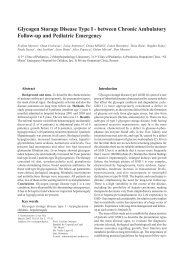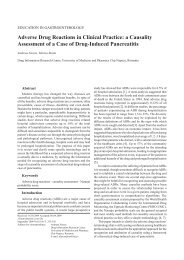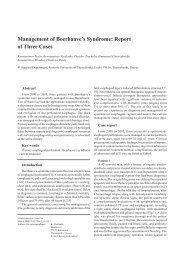Contents - Journal of Gastrointestinal and Liver Diseases
Contents - Journal of Gastrointestinal and Liver Diseases
Contents - Journal of Gastrointestinal and Liver Diseases
You also want an ePaper? Increase the reach of your titles
YUMPU automatically turns print PDFs into web optimized ePapers that Google loves.
VOLUME 19 NUMBER 3 SEPTEMBER 2010<br />
Editorials<br />
<strong>Contents</strong><br />
JGLD has got its first impact factor<br />
M. Acalovschi.................................................................................................................................................................239<br />
Is the future <strong>of</strong> Romanian gastroenterology training bright?<br />
C.J.J. Mulder..................................................................................................................................................................243<br />
Image <strong>of</strong> the issue<br />
Incarcerated umbilical hernia after large volume paracentesis for refractory ascites<br />
C.K. Triantos, I. Kehagias, V. Nikolopoulou, A.K. Burroughs......................................................................................245<br />
Original Papers<br />
Alkaline reflux esophagitis in patients with total gastrectomy <strong>and</strong> Roux en Y esojejunostomy<br />
D. Matei, R. Dadu, R. Prundus, I. Danci, L. Ciobanu, T. Mocan, C. Bocsan, R. Zaharie,<br />
A. Serban, M. Tantau, C. Iancu, I. Alex<strong>and</strong>ru, N. Al-Hajjar, V. Andreica....................................................................247<br />
Association <strong>of</strong> gastroesophageal reflux disease symptoms with exacerbations <strong>of</strong> chronic obstructive pulmonary<br />
disease<br />
M. Rogha, B. Behravesh, Z. Pourmoghaddas ...............................................................................................................253<br />
Faecal lact<strong>of</strong>errin, capsule endoscopy <strong>and</strong> Crohn’s disease. Is there a three way relationship?<br />
A pilot study<br />
R. Sidhu, D.S. S<strong>and</strong>ers, P. Wilson, L. Foye, S. Morley. M.E. McAlindon......................................................................257<br />
Outcome <strong>of</strong> antiviral treatment in patients with chronic genotype 1 HCV hepatitis. A retrospective study in 507<br />
patients<br />
I. Sporea, R. Sirli, M. Curescu, L. Gheorghe, A. Popescu, S. Bota, S. Iacob................................................................261<br />
Effects <strong>of</strong> pro-inflammatory cytokines on the production <strong>of</strong> soluble fractalkine <strong>and</strong> ADAM17<br />
by HepG2 cells<br />
S.L. Turner, D. Mangnall, N.C. Bird, M.E. Blair-Zajdel, R.A.D. Bunning....................................................................265<br />
Analysis <strong>of</strong> the common vasoactive intestinal peptide receptor 1 polymorphism in gallstone patients<br />
M. Krawczyk, M. Rusticeanu, F. Grünhage, M. Mahler, P. Portincasa, M. Acalovschi,<br />
F.Lammert......................................................................................................................................................................273<br />
Prevalence <strong>of</strong> gastroparesis in type 1 diabetes mellitus <strong>and</strong> its relationship to dyspeptic symptoms<br />
C. Sfarti, A. Trifan, C. Hutanasu, C. Cojocariu, A.M. Singeap, C. Stanciu..................................................................279<br />
Survival <strong>and</strong> quality <strong>of</strong> life <strong>of</strong> cholangiocarcinoma patients: a prospective study over a 4 year period<br />
F.Mihalache, M.Tantau, B. Diaconu, M. Acalovschi....................................................................................................285<br />
Reviews<br />
Dosing 6-thioguanine in inflammatory bowel disease: expert-based guidelines for daily practice<br />
M.L. Seinen, D.P. van Asseldonk, C.J.J Mulder, N.K.H. de Boer.................................................................................291<br />
Cyclic antibiotic therapy for diverticular disease: a critical reappraisal<br />
A. Zullo, C. Hassan, G. Maconi, G. Manes, G. Tammaro, V. De Francesco, B. Annibale,<br />
L. Ficano, L. Buri, G. Gatto, R. Lorenzetti, S.M. Campo, E. Ierardi, F. Pace, S. Morini.............................................295<br />
Clostridium difficile infection <strong>and</strong> liver disease<br />
S. Musa, C. Moran, T. Rahman......................................................................................................................................303<br />
Education in Gastroenterology<br />
WGO global guideline. Hepatocellular carcinoma (HCC): a global perspective<br />
P. Ferenci, M. Fried, D. Labrecque, J. Bruix, M. Sherman, M. Omata, J. Heathcote,<br />
T. Piratsivuth, M. Kew, J.A. Otegbayo, S.S. Zheng, S. Sarin, S. Hamid, S.B. Modawi,
W. Fleig, S. Fedail, A. Thomson, A. Khan, P. Malfertheiner, G. Lau, F.J. Carillo,<br />
J. Krabshuis, A. Le Mair................................................................................................................................................311<br />
Quiz HQ 58. Walled <strong>of</strong>f cecal mass: an unusual case with an unusual presentation<br />
R. Kibria, F. Ashraf, S.A. Ali, C.J. Barde......................................................................................................................319<br />
Case Reports<br />
An unusual cause <strong>of</strong> dysphagia: esophageal tuberculosis<br />
T.M. Welzel, T. Kawan, W. Bohle, G.M. Richter, A. Bosse, W.G. Zoller.......................................................................321<br />
Incomplete deployment <strong>of</strong> an exp<strong>and</strong>able metallic stent in a patient with esophageal malignant stenosis<br />
G. Dim<strong>of</strong>te, R. Moldovanu, F. Crumpei, O. Grigoras, E. Tarcoveanu..........................................................................325<br />
Rapid recovery <strong>of</strong> a rectovaginal fistula with infliximab in a patient with Crohn’s disease<br />
C. Hagiu, R. Badea, A. Serban, S. Petrar, V. Andreica.................................................................................................329<br />
Acute spontaneous chylous peritonitis: report <strong>of</strong> a case<br />
I. Mishin, G. Ghidirim, M. Vozian.................................................................................................................................333<br />
Letters<br />
Ranitidine induced hepatitis<br />
T.H. Lee, K.J. Vega, J.G. El Khoury..............................................................................................................337<br />
More on serum markers <strong>of</strong> liver fibrosis: are they still clinically limited?<br />
P. Vajro..........................................................................................................................................................................338<br />
Reply<br />
H. Parsian......................................................................................................................................................................339<br />
Is it untrue that ultrasonography guidance is superior to the blind method for liver biopsy?<br />
E. Zerem, N. Salkic, P. Jovanovic..................................................................................................................................339<br />
Reply<br />
Z.A. Cetinkaya, M. Sezikli, F. Guzelbulut, Y.Z. Benek, S. Ozkara, Y. Gokden, B. Yasar,<br />
O.O. Kurdas...................................................................................................................................................................340<br />
Primary neuroendocrine tumor <strong>of</strong> the extrahepatic biliary tree mimicking Klatskin tumor<br />
K. Tsalis, G. Vrakas, T. Geroukis, A. Cheva, G.N. Roidos, C. Lazarides......................................................................341<br />
Emergence <strong>of</strong> Crohn’s disease in juvenile idiopathic arthritis, during treatment with etanercept:<br />
a causal link or a mere coincidence?<br />
K.A. Oikonomou, A.N. Kapsoritakis, F.D. Tsiopoulos, A.N. Tsikouras, S. Potamianos................................................342<br />
Calendar <strong>of</strong> Events.....................................................................................................................................................343<br />
Guidance for Authors.................................................................................................................................................346<br />
ORIGINAL PAPERS
Alkaline Reflux Esophagitis in Patients with Total Gastrectomy <strong>and</strong><br />
Roux en Y Esojejunostomy<br />
Daniela Matei 1 , Razvan Dadu 1 , Raluca Prundus 1 , Ioana Danci 2 , Lidia Ciobanu 1 , Teodora Mocan 3 , Corina Bocsan 4 , Roxana<br />
Zaharie 1 , Alex<strong>and</strong>ru Serban 1 , Marcel Tantau 1 , Cornel Iancu 5 , Irimie Alex<strong>and</strong>ru 6 , Nadim Al-Hajjar 5 , Vasile Andreica 1<br />
1) 3rd Medical Clinic; 2) 5th Medical Clinic; 3) Pathophysiology Department; 4) Pharmacology Department; 5) 3rd<br />
Surgery Clinic, University <strong>of</strong> Medicine <strong>and</strong> Pharmacy „Iuliu Haţieganu”; 6) „I. Chiricuta” Institute <strong>of</strong> Oncology, Cluj<br />
Napoca, Romania<br />
Abstract<br />
Background <strong>and</strong> Aims. Alkaline reflux esophagitis is a complication that might develop in patients with total gastrectomy.<br />
The aim <strong>of</strong> the study was to analyze the prevalence <strong>and</strong> severity <strong>of</strong> reflux esophagitis <strong>and</strong> the occurence <strong>of</strong> complications<br />
(Barrett’s esophagus <strong>and</strong> esophageal stenosis) in patients with total gastrectomy <strong>and</strong> Roux en Y esojejunostomy. Methods. 92<br />
patients with total gastrectomy performed for gastric cancer were included in the study. None <strong>of</strong> the patients had esophagitis prior<br />
to gastrectomy. The patients were assessed clinically <strong>and</strong> endoscopically after a certain interval from surgery. Results. An<br />
important number <strong>of</strong> patients (14 out <strong>of</strong> 92, 15.22%) had reflux esophagitis; 5.43% <strong>of</strong> the patients had also complications <strong>of</strong> reflux<br />
esophagitis (Barrett’s esophagus <strong>and</strong> benign esophageal stenosis) <strong>and</strong> 6.52% had local tumor recurrence. Of the 14 patients with<br />
reflux esophagitis, the majority (9/14) had Los Angeles (LA) grade C esophagitis. The mean interval between surgery <strong>and</strong> the<br />
endoscopic evaluation was 4.43 years. Barrett’s esophagus <strong>and</strong> benign stenosis were diagnosed after a longer period <strong>of</strong> time<br />
(10.33 <strong>and</strong> 8 years, respectively) as compared to reflux esophagitis (5.29 years). More than half <strong>of</strong> the esophagitis patients had<br />
reflux symptoms. Conclusions. Although Roux en Y esojejunostomy is a reconstructive technique which prevents the reflux, an<br />
important percentage <strong>of</strong> our patients developed alkaline reflux esophagitis. In most cases, the esophagitis was moderate or severe.<br />
Complications <strong>of</strong> alkaline reflux, i.e. benign stenosis <strong>and</strong> Barrett’s esophagus, also occurred after longer periods <strong>of</strong> time (8 to 10<br />
years) in a small percentage <strong>of</strong> patients.<br />
Key words<br />
Alkaline reflux esophagitis - total gastrectomy - Roux en Y esojejunostomy - gastric cancer - Barrett’s esophagus - esophageal<br />
stenosis.
Association <strong>of</strong> Gastroesophageal Reflux Disease Symptoms with<br />
Exacerbations <strong>of</strong> Chronic Obstructive Pulmonary Disease<br />
Mehran Rogha 1 , Bahare Behravesh 2 , Zahra Pourmoghaddas 2<br />
1) Department <strong>of</strong> Internal Medicine; 2) Young Researchers Clubs, Islamic Azad University, Najafabad Branch,<br />
Najafabad, Iran<br />
Abstract<br />
Background: Symptoms <strong>of</strong> gastroesophageal reflux disease (GERD) are common in various chronic respiratory diseases, but<br />
little is known about GERD in the setting <strong>of</strong> chronic obstructive pulmonary disease (COPD). The aim <strong>of</strong> this study was to<br />
determine the effect <strong>of</strong> GERD symptoms on COPD exacerbations <strong>and</strong> subsequent hospitalization <strong>and</strong> drug usage. Methods: This<br />
retrospective study was conducted from December 2008 to February 2009 in the Pulmonary Clinic <strong>of</strong> Dr. Shariati University<br />
Hospital, Isfahan, Iran. Consecutive patients who were diagnosed with COPD based on clinical features <strong>and</strong> pulmonary function<br />
tests were included. Patients were categorized in GERD positive <strong>and</strong> GERD negative groups based on the Mayo GERD<br />
questionnaire. Exacerbation <strong>of</strong> COPD, hospitalization, <strong>and</strong> drug usage were compared between the two groups. Results: During<br />
the study period, 110 patients with COPD (mean age = 68.0 ± 8.4 years, 87.3% male) were included; 59 (53.6%) patients were<br />
GERD positive. There was no significant difference between the GERD positive <strong>and</strong> GERD negative patients in age, gender,<br />
tobacco use, or body mass index. GERD positive patients experienced significantly more acute exacerbations <strong>of</strong> COPD than<br />
patients who were GERD negative (p
Faecal Lact<strong>of</strong>errin, Capsule Endoscopy <strong>and</strong> Crohn’s Disease. Is<br />
there a Three Way Relationship? A Pilot Study<br />
Reena Sidhu 1 , David S S<strong>and</strong>ers 1 , Perm Wilson 2 , Laura Foye 2 , Stephen Morley 2 . Mark E McAlindon 1<br />
1) Gastroenterology & <strong>Liver</strong> Unit; 2) Department <strong>of</strong> Clinical Chemistry, Royal Hallamshire Hospital, Sheffield,<br />
United Kingdom<br />
Abstract<br />
Background & Aims: Capsule endoscopy has been shown to be useful in diagnosing small bowel Crohn’s disease. Faecal<br />
lact<strong>of</strong>errin has been shown to have a high sensitivity <strong>and</strong> specificity in discriminating between inflammatory bowel disease <strong>and</strong><br />
irritable bowel syndrome. There have been no studies on the use <strong>of</strong> faecal lact<strong>of</strong>errin in the setting <strong>of</strong> suspected Crohn’s disease<br />
using capsule endoscopy. Our aim was to investigate the clinical utility <strong>of</strong> lact<strong>of</strong>errin in patients with suspected Crohn’s disease<br />
using capsule endoscopy. Methods: Data was collected prospectively on patient symptoms, family history <strong>and</strong> blood parameters.<br />
Patients were requested to return a stool sample <strong>and</strong> quantitative analysis using s<strong>and</strong>wich ELISA was performed for faecal<br />
lact<strong>of</strong>errin. Results: Seventeen patients were recruited with all patients having had more than one criterion for referral. The<br />
diagnostic yield for capsule endoscopy was 41%, <strong>of</strong> which 71% <strong>of</strong> patients had an elevated faecal lact<strong>of</strong>errin (correlation<br />
coefficient 0.56, p=0.01). The sensitivity, specificity, positive predictive value <strong>and</strong> negative predictive value <strong>of</strong> faecal lact<strong>of</strong>errin<br />
were 71%, 100%, 100% <strong>and</strong> 83%, respectively. Conclusion: Faecal lact<strong>of</strong>errin has a high positive <strong>and</strong> negative predictive value<br />
for the diagnosis <strong>of</strong> small bowel Crohn’s disease, detected by capsule endoscopy. Faecal lact<strong>of</strong>errin is a useful marker (in<br />
conjunction with clinical parameters) to determine which patients should be referred for capsule endoscopy.<br />
Key words<br />
Faecal lact<strong>of</strong>errin - Crohn’s disease - capsule endoscopy.
Outcome <strong>of</strong> Antiviral Treatment in Patients with Chronic Genotype<br />
1 HCV Hepatitis. A Retrospective Study in 507 Patients<br />
Ioan Sporea 1 , Roxana Sirli 1 , Manuela Curescu 2 , Liana Gheorghe 3 , Alina Popescu 1 , Simona Bota 1 , Speranţa Iacob 3<br />
1) Department <strong>of</strong> Gastroenterology <strong>and</strong> Hepatology; 2) Department <strong>of</strong> Infectious <strong>Diseases</strong>, University <strong>of</strong> Medicine<br />
<strong>and</strong> Pharmacy, Timişoara; 3) Hepatology Department, Center <strong>of</strong> Gastroenterology <strong>and</strong> Hepatology, Fundeni Clinical<br />
Institute, “Carol Davila” University <strong>of</strong> Medicine <strong>and</strong> Pharmacy, Bucharest, Romania<br />
Abstract<br />
Background <strong>and</strong> aim: The current st<strong>and</strong>ard <strong>of</strong> care in chronic HCV genotype 1 hepatitis is the combination <strong>of</strong> pegylated<br />
interferon (PegIFN) with ribavirin for 48 weeks. The aim <strong>of</strong> our paper was to verify if there are significant differences regarding<br />
the sustained virologic response (SVR) in patients treated with PegIFN alfa-2a vs. those treated PegIFN alfa-2b, both in<br />
combination with ribavirin. Method: We performed a retrospective study on 507 patients with chronic viral C hepatitis treated<br />
with PegIFN alpha-2a 180 μg/kg/week or PegIFN alpha-2b 1.5 μg/kg/week plus ribavirin in the recommended doses according to<br />
weight, following the current treatment guidelines. We evaluated the SVR defined as PCR RNA-HCV undetectable 24 weeks<br />
after the end <strong>of</strong> treatment. Results: There were no differences regarding the baseline characteristics among the subgroups <strong>of</strong><br />
patients treated with PegIFN alpha-2a or PegIFN alpha-2b concerning the pretreatment viral load (p=0.2445), the severity <strong>of</strong><br />
fibrosis (p=0.2403), the mean age <strong>of</strong> the patients (p=0.9597) <strong>and</strong> the women/men ratio (p=0.2087). The SVR rates in patients<br />
treated with PegIFN alpha-2a were similar to those in patients treated with PegIFN alpha-2b: 208/338 (61.5%) vs. 94/169 (55.6%)<br />
(p=0.2129). Conclusion: Sustained virologic response rates were similar in HCV genotype 1 patients treated with PegIFN alpha-<br />
2a <strong>and</strong> with Peg-IFN alpha-2b.<br />
Keywords<br />
HCV hepatitis - sustained virologic response - early virologic response - pegylated interferon - ribavirin - genotype 1 HCV.
Effects <strong>of</strong> Pro-Inflammatory Cytokines on the Production <strong>of</strong><br />
Soluble Fractalkine <strong>and</strong> ADAM17 by HepG2 Cells<br />
Sharon L. Turner 1 , David Mangnall 2 , Nigel C. Bird 2 , Maria E. Blair-Zajdel 1 , Rowena A.D. Bunning 1<br />
1) Biomedical Research Centre, Sheffield Hallam University, Sheffield; 2) <strong>Liver</strong> Research Group, Royal Hallamshire<br />
Hospital, University <strong>of</strong> Sheffield, Sheffield, UK<br />
Abstract<br />
Background & Aims: Soluble fractalkine is increased in the liver during times <strong>of</strong> injury; however the effect <strong>of</strong> proinflammatory<br />
cytokines in this process is currently unknown. The aim <strong>of</strong> this study was to determine whether pro-inflammatory<br />
cytokines elevated in patients with hepatocellular carcinoma influence fractalkine shedding from HepG2 cells <strong>and</strong> whether<br />
ADAM17 was involved in this process. Methods: In vitro experiments were performed in the human hepatocellular carcinoma<br />
cell line HepG2. Soluble fractalkine was detected using an ELISA. ADAM17 expression was investigated using quantitative real<br />
time (reverse transcription)-polymerase chain reaction <strong>and</strong> flow cytometry. Short interfering RNA transfection was used to downregulate<br />
ADAM17 expression. Results: Soluble fractalkine was present in supernatants <strong>of</strong> HepG2 cells, <strong>and</strong> was significantly<br />
increased by interleukin-1β (p≤0.005) <strong>and</strong> tumour necrosis factor-α (p≤0.043), but not by interleukin-6 (p≥0.316). This<br />
corresponded to minor increases in ADAM17 protein, but not ADAM17 mRNA, following the same treatments. However, the<br />
down-regulation <strong>of</strong> ADAM17 protein did not affect fractalkine shedding. Conclusions: This study showed that soluble fractalkine<br />
is up-regulated under inflammatory conditions associated with hepatocellular carcinoma development, but ADAM17 does not<br />
appear to be responsible for regulating this process.<br />
Keywords<br />
Fractalkine - ADAM17 - cytokines - cancer - hepatocellular carcinoma - HepG2.
Analysis <strong>of</strong> the Common Vasoactive Intestinal Peptide Receptor 1<br />
Polymorphism in Gallstone Patients<br />
Marcin Krawczyk 1 , Monica Rusticeanu 1 , Frank Grünhage 1 , Miriam Mahler 1 , Piero Portincasa 2 , Monica Acalovschi 3 , Frank<br />
Lammert 1<br />
1) Department <strong>of</strong> Medicine II, Saarl<strong>and</strong> University Hospital, Saarl<strong>and</strong> University, Homburg, Germany; 2) Clinica<br />
Medica “Augusto Murri”, Department <strong>of</strong> Internal <strong>and</strong> Public Medicine, University Medical School, Bari, Italy; 3)<br />
Department <strong>of</strong> Medicine III, Iuliu Hatieganu University <strong>of</strong> Medicine <strong>and</strong> Pharmacy, Cluj-Napoca, Romania<br />
Abstract<br />
Background <strong>and</strong> aim: Cholesterol gallstone disease is caused by both genetic <strong>and</strong> environmental factors (e.g., deranged<br />
motility <strong>of</strong> the gallbladder wall). Recently, a single nucleotide polymorphism (SNP) <strong>of</strong> the vasoactive intestinal peptide receptor 1<br />
(VIPR1) gene has been linked to late onset <strong>of</strong> achalasia, a lower esophagus dysmotility disorder. As VIPR1 is expressed in the<br />
gallbladder wall as well, <strong>and</strong> patients with achalasia exhibit extraesophageal motility disorders, the influence <strong>of</strong> VIPR1 SNP on<br />
cholelithiasis was investigated. Methods: We analyzed 254 gallstone-free controls (confirmed by ultrasound, age 21-78 years,<br />
88% women, BMI 16-43 kg/m 2 ) <strong>and</strong> 226 individuals from 107 families with gallstones (age 24-80 years, 87% women, BMI 17-55<br />
kg/m 2 ). All individuals were genotyped for the VIPR1 rs437876 SNP (intron 4) with PCR-based 5’-nuclease <strong>and</strong> fluorescence<br />
detection assays (TaqMan). We performed nonparametric linkage (NPL) analysis in affected sib-pairs (ASP), association tests,<br />
<strong>and</strong> regression analyses. Results: Controls were significantly younger (P < 0.01) <strong>and</strong> leaner than ASP <strong>and</strong> cases (P < 0.01), <strong>and</strong><br />
both age as well as BMI significantly increased the risk <strong>of</strong> developing gallstones (P < 0.001). Allele frequencies were in line with<br />
database entries <strong>and</strong> no deviation from Hardy-Weinberg equilibrium was detected. Neither allele <strong>and</strong> genotype distributions nor<br />
NPL scores or the restriction <strong>of</strong> analysis to individuals older than 50 years provided evidence for association or linkage <strong>of</strong> the<br />
VIPR1 SNP <strong>and</strong> cholelithiasis. Conclusion: The VIPR1 polymorphism, previously linked to gastrointestinal dysmotility<br />
disorders, does not represent a common risk factor for gallstones in the general or in an elderly population.<br />
Key words<br />
Achalasia - cholelithiasis - gallbladder motility - single nucleotide polymorphism.
Prevalence <strong>of</strong> Gastroparesis in Type 1 Diabetes Mellitus <strong>and</strong> its<br />
Relationship to Dyspeptic Symptoms<br />
Catalin Sfarti, Anca Trifan, Catalin Hutanasu, Camelia Cojocariu, Ana-Maria Singeap, Carol Stanciu<br />
University <strong>of</strong> Medicine <strong>and</strong> Pharmacy ”Gr. T. Popa” Iasi, Romania<br />
Abstract<br />
Background <strong>and</strong> Aim: Gastroparesis <strong>and</strong>/or dyspeptic symptoms occur in around 50% <strong>of</strong> type 1 diabetic patients. The aim <strong>of</strong><br />
our study was to evaluate the prevalence <strong>of</strong> gastroparesis in patients with type 1 diabetes using 13 C-octanoic acid breath test ( 13 C-<br />
OBT) <strong>and</strong> the relationship between dyspeptic symptoms <strong>and</strong> gastric emptying. Methods: Gastric emptying <strong>of</strong> solids was<br />
evaluated prospectively in euglycemic conditions in 69 type 1 diabetic patients (male/female: 36/33; mean age 49.5 ± 14.2 years;<br />
mean duration <strong>of</strong> diabetes 20.4 ± 8.2 years) <strong>and</strong> 40 healthy volunteers (male/female 17/23; mean age 34.3 ± 16 years) using 13 C-<br />
OBT. Dyspeptic symptoms, autonomic nerve function <strong>and</strong> Helicobacter pylori (H. pylori) status were assessed. Results: Solid<br />
gastric emptying was slower in diabetic patients (T1/2=125.36 ± 31.5min) than in healthy subjects (T1/2=88.5 ± 27.3 min)<br />
(p
Survival <strong>and</strong> Quality <strong>of</strong> Life <strong>of</strong> Cholangiocarcinoma Patients: a<br />
Prospective Study over a 4 Year Period<br />
Florentina Mihalache, Marcel Tantau, Brindusa Diaconu, Monica Acalovschi<br />
3 rd Medical Clinic, University <strong>of</strong> Medicine <strong>and</strong> Pharmacy, Cluj Napoca, Romania<br />
Abstract<br />
Background <strong>and</strong> aims: Cholangiocarcinomas (CCAs) are tumors with a poor prognosis <strong>and</strong> a lower quality <strong>of</strong> life (QoL). The<br />
aim <strong>of</strong> this study was to evaluate the survival rate <strong>and</strong> quality <strong>of</strong> life in CCA patients. Method: We prospectively enrolled 133<br />
patients diagnosed with CCA in the 3rd Medical Clinic, Cluj Napoca, over a 4-year period (2005-2009). The QoL was evaluated<br />
by means <strong>of</strong> a QoL questionnaire (EORTC QLQ-C30). Results: The mean age <strong>of</strong> the patients was 65 ± 10.6 years: 55% were<br />
males. 71% <strong>of</strong> the patients had hilar tumor (Klatskin), 23% distal <strong>and</strong> 6% intrahepatic CCA (IH). Only 11.3% <strong>of</strong> the patients were<br />
eligible to receive curative treatment. The 1-year overall survival was 22.3 ± 4.4% <strong>and</strong> the 2-year survival was 3.4 ± 2.1%. The<br />
patients receiving metallic stents had better survival than those receiving plastic stents (40.4% vs 12.5% at 1 year, 9.1% vs 5.0% at<br />
2 years, respectively). The 1-year survival was significantly improved for patients who underwent surgery plus adjuvant<br />
chemotherapy. The post-therapy QoL demonstrated a less improvement in Klatskin tumor patients than in patients with other<br />
types <strong>of</strong> tumors. Endoscopic palliative therapy allowed a faster community reintegration, but with variable evolution.<br />
Conclusions: The highest 2-year survival rate was 5.5%. Slightly longer survival was recorded when chemotherapy was added<br />
<strong>and</strong> also after endoscopic placement <strong>of</strong> metallic stents. Endoscopic biliary decompression improved the QoL faster than surgery.<br />
Key words<br />
Cholangiocarcinoma - survival - quality <strong>of</strong> life - biliary stents - adjuvant chemotherapy - curative surgery - TNM stages.
REVIEWS<br />
Dosing 6-Thioguanine in Inflammatory Bowel Disease: Expert-<br />
Based Guidelines for Daily Practice<br />
Margien L Seinen, Dirk P van Asseldonk, Chris J J Mulder, Nanne K H de Boer<br />
VU University Medical Centre, Department <strong>of</strong> Gastroenterology <strong>and</strong> Hepatology, Amsterdam, The Netherl<strong>and</strong>s<br />
Abstract<br />
Conventional thiopurines are considered to be effective <strong>and</strong> safe in the treatment <strong>of</strong> inflammatory bowel disease (IBD)<br />
patients; unfortunately more than 50% <strong>of</strong> patients discontinue thiopurine therapy, mainly due to the development <strong>of</strong> intractable<br />
adverse events. In recent years, the use <strong>of</strong> 6-thioguanine has been proposed as an alternative thiopurine in IBD patients failing to<br />
tolerate or to respond to conventional thiopurine therapy. In this clinical review, we describe the rationale for 6-thioguanine<br />
therapy <strong>and</strong> discuss the reported hepatotoxicity <strong>of</strong> 6-thioguanine (especially nodular regenerative hyperplasia). We propose<br />
expert-based guidelines for balanced treatment.<br />
Key words<br />
6-thioguanine - Crohn’s disease - ulcerative colitis - thiopurines - side-effects - nodular regenerative hyperplasia - guidelines.
Cyclic Antibiotic Therapy for Diverticular Disease: a Critical<br />
Reappraisal<br />
Angelo Zullo 1 , Cesare Hassan 1 , Giovanni Maconi 2 , Gianpiero Manes 2 , Gianfranco Tammaro 3 , Vincenzo De Francesco 4 , Bruno<br />
Annibale 5 , Leonardo Ficano 6 , Luigi Buri 7 , Giovanni Gatto 8 , Roberto Lorenzetti 1 , Salvatore M. Campo 1 , Enzo Ierardi 4 , Fabio<br />
Pace 9 , Sergio Morini 1<br />
1) Gastroenterology Unit, “Nuovo Regina Margherita” Hospital, Rome; 2) Dept. <strong>of</strong> Clinical Sciences, Division <strong>of</strong><br />
Gastroenterology, “L. Sacco” University Hospital, Milan; 3) Gastroenterology Unit, “Sant’Eugenio” Hospital, Rome;<br />
4) Section <strong>of</strong> Gastroenterology, Department <strong>of</strong> Medical Sciences, University <strong>of</strong> Foggia, Foggia; 5) Dept. <strong>of</strong> Digestive<br />
<strong>and</strong> <strong>Liver</strong> <strong>Diseases</strong>, University “La Sapienza”, Sant’Andrea Hospital Rome; 6) Department <strong>of</strong> Oncology, Division <strong>of</strong><br />
General <strong>and</strong> Oncological Surgery, University <strong>of</strong> Palermo, Palermo; 7) Gastroenterology <strong>and</strong> Digestive Endoscopy<br />
Unit, “Cattinara’’ Hospital, Trieste; 8) Gastroenterology <strong>and</strong> Digestive Endoscopy Unit “Villa S<strong>of</strong>ia” Hospital<br />
Palermo; 9) Gastroenterology, “Bolognini” Hospital, Seriate, Italy<br />
Abstract<br />
Different symptoms have been attributed to uncomplicated diverticular disease (DD). Poor absorbable antibiotics are largely<br />
used for uncomplicated DD, mainly for symptom treatment <strong>and</strong> prevention <strong>of</strong> diverticulitis onset. Controlled trials on cyclic<br />
administration <strong>of</strong> rifaximin in DD patients were evaluated. Four controlled, including 1 double-blind <strong>and</strong> 3 open-label,<br />
r<strong>and</strong>omized studies were available. Following a long-term cyclic therapy, a significant difference emerged in the global symptoms<br />
score (range: 0-18) between rifaximin plus fibers (from 6-6.5 to 1-2) <strong>and</strong> fibers alone (from 6.7 to 2-3.8), although the actual<br />
clinically relevance <strong>of</strong> such a very small difference remains to be ascertained. Moreover, a similar global symptom score reduction<br />
(from 6 to 2.4) can be achieved by simply recommending an inexpensive high-fiber diet. Current data suggest that cyclic rifaximin<br />
plus fibers significantly reduce the incidence <strong>of</strong> the first episode <strong>of</strong> acute diverticulitis as compared to fibers alone (1.03% vs<br />
2.75%), but a cost-efficacy analysis is needed before this treatment can be routinely recommended. The available studies have<br />
been hampered by some limitations, <strong>and</strong> definite conclusions could not be drawn. The cost <strong>of</strong> a long-life, cyclic rifaximin therapy<br />
administered to all symptomatic DD patients would appear prohibitive.<br />
Key words<br />
Diverticular disease - therapy - symptoms - rifaximin - diverticulitis - haemorrhage.
Clostridium Difficile Infection <strong>and</strong> <strong>Liver</strong> Disease<br />
Saif Musa, Carl Moran, Tony Rahman<br />
Department <strong>of</strong> Gastroenterology & Hepatology, St. George’s Hospital, Blackshaw Rd, London, UK<br />
Abstract<br />
The rates <strong>of</strong> the predominantly hospital acquired infection, Clostridium difficile, have increased throughout the world. Several<br />
risk factors <strong>and</strong> susceptible patient populations have been identified. Patients with pre-existing liver disease represent an important<br />
cohort; recent evidence suggests that Clostridium difficile infection (CDI) is associated with a worse outcome <strong>and</strong> increased health<br />
care costs. This review focuses on the epidemiology, risk factors, pathogenesis, treatment options <strong>and</strong> outcomes associated with<br />
CDI in patients with liver disease.<br />
Keywords<br />
Clostridium difficile - Clostridium difficile infection enterocolitis - pseudomembranous - epidemiology - liver diseases - risk<br />
factors <strong>and</strong> treatment.
CASE REPORTS<br />
An Unusual Cause <strong>of</strong> Dysphagia: Esophageal Tuberculosis<br />
Tania M. Welzel 1 , Thomas Kawan 1 , Wolfram Bohle 1 , Götz M. Richter 2 , Alex<strong>and</strong>er Bosse 3 , Wolfram G. Zoller 1<br />
1) Department <strong>of</strong> Internal Medicine, Gastroenterology, Hepatology <strong>and</strong> Infectious <strong>Diseases</strong>; 2) Department <strong>of</strong><br />
Radiology; 3) Department <strong>of</strong> Pathology, Klinikum Stuttgart, Katharinenhospital, Stuttgart, Germany<br />
Abstract<br />
A 25-year old Indian exchange-student presented to our department with a three week history <strong>of</strong> dysphagia. Diagnostic<br />
evaluation by upper gastrointestinal endoscopy, endosonography <strong>and</strong> chest-CT revealed a tumor-suspect ulcerative lesion at the<br />
middle esophagus, <strong>and</strong> a mediastinal lymph node enlargement. Initial histopathological evaluation <strong>of</strong> multiple esophageal tissue<br />
biopsies showed an unspecific esophagitis without signs for malignancy. A positive T-spot ® .TB assay result, together with the<br />
bronchoscopic detection <strong>of</strong> a small exophytic lesion at the right main bronchus depicting caseating epitheloid cell granulomas,<br />
provided evidence for a tuberculous etiology <strong>of</strong> the esophageal tumor. Multiple further deep submucosal biopsies were needed to<br />
finally detect epitheloid cell granulomas in the esophageal lesion. Microbacteriological or molecular tests were negative for M.<br />
tuberculosis. Tuberculostatic treatment resulted in a good response with complete remission <strong>of</strong> the esophageal lesion <strong>and</strong> the<br />
mediastinal lymph node enlargement. Esophageal tuberculosis is rare in developed countries, <strong>and</strong> its possible presence deserves<br />
consideration particularly in patients at risk.<br />
Keywords<br />
Dysphagia - ulcerating esophageal lesion - M. tuberculosis - esophageal tuberculosis.
Incomplete Deployment <strong>of</strong> an Exp<strong>and</strong>able Metallic Stent in a<br />
Patient With Esophageal Malignant Stenosis<br />
Gabriel Dim<strong>of</strong>te¹, Radu Moldovanu¹, Felicia Crumpei 2 , Oana Grigoras 3 , Eugen Tarcoveanu 1<br />
1) Department <strong>of</strong> Surgery; 2) Department <strong>of</strong> Radiology; 3) Department <strong>of</strong> Intensive Care <strong>and</strong> Anesthesia, “Gr. T. Popa”<br />
University <strong>of</strong> Medicine <strong>and</strong> Pharmacy “St. Spiridon University Hospital” Iaşi, Romania<br />
Abstract<br />
The use <strong>of</strong> self exp<strong>and</strong>able metallic stents (SEMS) in the palliation <strong>of</strong> dysphagia due to malignant esophageal stenosis is a gold<br />
st<strong>and</strong>ard. Covered stents are used in all cases with overt air-digestive fistula or high potential for fistula development. The<br />
procedure is associated with a low incidence <strong>of</strong> procedure-related complications. We present a case with a major accident which<br />
developed during stent deployment. The delivery system became blocked <strong>and</strong> we found it impossible to fully deploy the stent,<br />
which remained attached to the introductory system. The stent was forcefully removed <strong>and</strong> replaced later on with a new stent. This<br />
is the first report <strong>of</strong> a SEMS related accident due to malfunction <strong>of</strong> the stent deployment system. Stent malfunction is unusual <strong>and</strong><br />
unlikely to happen, but one should be aware <strong>and</strong> prepared for such unusual situations.<br />
Key words<br />
Self exp<strong>and</strong>able metallic stent (SEMS) - esophageal malignant stenosis - incidents <strong>and</strong> accidents.
Rapid Recovery <strong>of</strong> a Rectovaginal Fistula with Infliximab in a<br />
Patient with Crohn’s Disease<br />
Claudia Hagiu, Radu Badea, Alex<strong>and</strong>ru Serban, Sabina Petrar, Vasile Andreica<br />
3 rd Medical Clinic, University <strong>of</strong> Medicine <strong>and</strong> Pharmacy, Cluj Napoca, Romania<br />
Abstract<br />
We present the case <strong>of</strong> a female patient diagnosed with colonic Crohn’s disease, having a clinical evolution with many<br />
recurrences <strong>and</strong> in whom conventional therapy had failed. The patient was admitted in our department 4 years after the onset <strong>of</strong><br />
the disease, with an altered general state, diarrhea, malnutrition, fever <strong>and</strong> fecaloid vaginal discharge. Investigations classified the<br />
patient in a severe activity flare <strong>of</strong> Crohn’s disease (CDAI 329), complicated with a rectovaginal fistula. Infliximab therapy was<br />
initiated. The evolution was rapidly favorable <strong>and</strong> the fistula closed after 4 weeks <strong>of</strong> therapy.<br />
Key words<br />
Crohn’s disease - endovaginal ultrasonography - rectovaginal fistula - infliximab.
Acute Spontaneous Chylous Peritonitis: Report <strong>of</strong> a Case<br />
Igor Mishin, Gheorghe Ghidirim, Marin Vozian<br />
First Department <strong>of</strong> Surgery „N. Anestiadi” & Laboratory <strong>of</strong> Hepato-Pancreato-Biliary Surgery, Medical University „N.<br />
Testemitsanu”, National Center <strong>of</strong> Emergency Medicine, Kishinev, Republic <strong>of</strong> Moldova<br />
Abstract<br />
Acute abdominal pain with peritonitis due to sudden extravasation <strong>of</strong> lymph into the peritoneal cavity is a rare condition that is<br />
<strong>of</strong>ten mistaken for other causes <strong>of</strong> acute abdomen. The diagnosis <strong>of</strong> spontaneous chylous peritonitis is rarely suspected<br />
preoperatively, usually misdiagnosed with diverse common surgical emergencies. We report the case <strong>of</strong> an 81 year old female<br />
who presented with typical symptoms <strong>of</strong> acute abdomen, presumed as acute mesenteric ischemia. The diagnosis <strong>of</strong> chylous<br />
peritonitis was established during laparoscopy <strong>and</strong> treatment consisted <strong>of</strong> low fat diet <strong>and</strong> octreotide.<br />
Key words<br />
Acute abdominal pain - chylous peritonitis - somatostatin.



